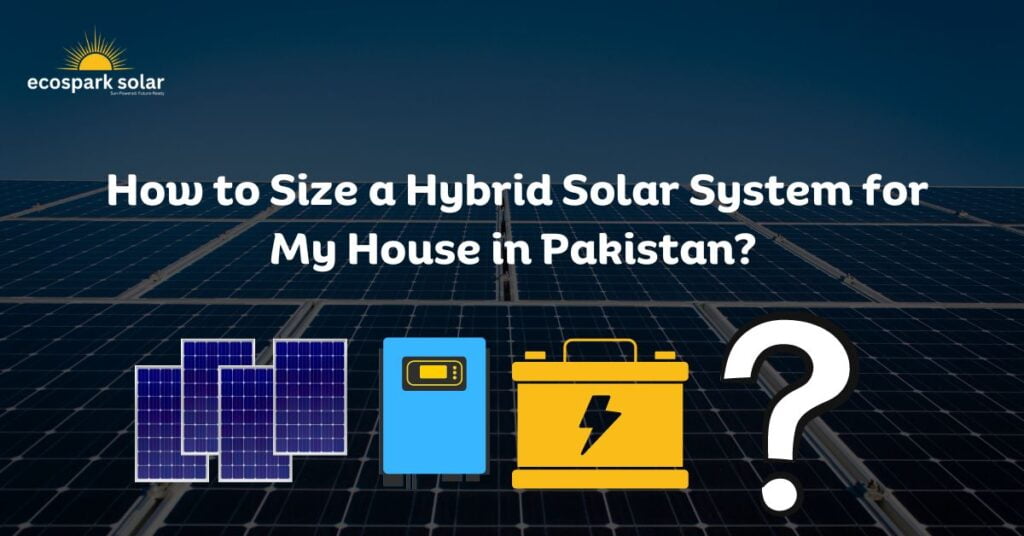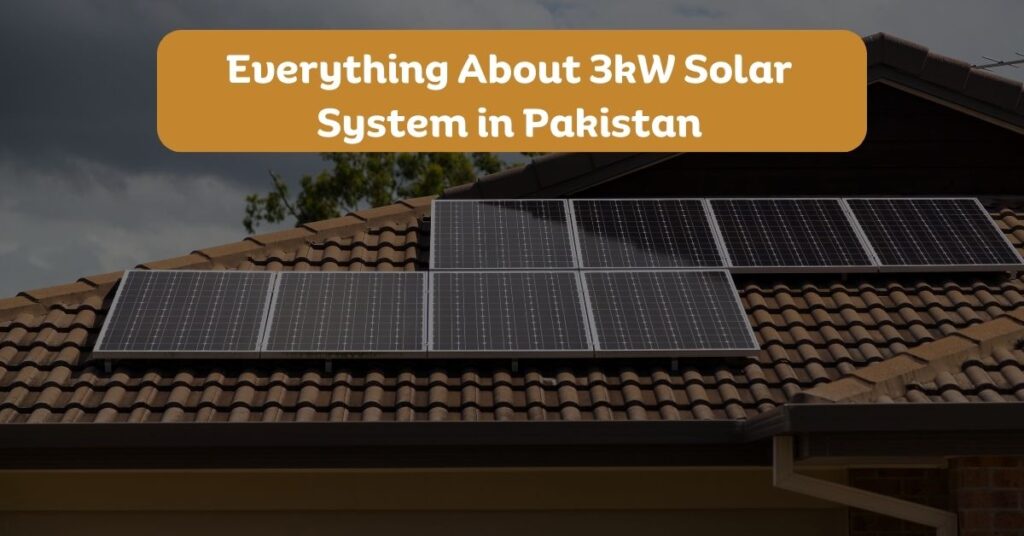This article only about sizing a hybrid system. For other types of systems, we have the following articles:
If you would like a hybrid system, please continue reading this article.
Hybrid solar systems are those systems that remain connected to the grid as well as batteries. They help you save on your electricity, and are capable to provide uninterrupted power supply even during load shedding.
But here’s the catch: getting the most out of these systems starts with sizing them right. “How to size a hybrid solar system for my home—or business,” you may ask.
That’s what we will be discussing in the lines below. We’ll walk you through the steps, from understanding your electricity consumption to choosing the perfect components, all to ensure your hybrid solar setup works efficiently and effectively.
How to Size a Hybrid Solar System for Your Home?
Sizing a hybrid solar system, or for that matter any type of solar system, doesn’t just mean calculating the size of your solar panels. It also means determining the size of your battery bank and selecting an appropriate inverter. That’s why we have divided this section into easy, understandable steps that work.
Step 1: Calculate Your Electricity Consumption
To properly size your hybrid solar system, you need to know your current electricity usage. Start by gathering your recent electricity bills showing your monthly kilowatt-hour (kWh) consumption—you will find this in the a column that says, “Units consumed.” Observe usage patterns, and highlight months with increased energy needs—the annual view on the right side would inform you of your monthly usage patterns.
For example, consumption will increase from April to August—if you live in plain areas, such as Lahore, Rawalpindi, Islamabad, Peshawar, etc.
Calculate your total annual unit consumption by summing up the past year’s bills. Divide this by 12 to find your average monthly consumption. Be mindful of potential changes like new appliances or energy-efficient upgrades that might alter your future consumption.
Once that’s done, divide your average monthly consumption by 30 to get your average daily consumption.
For the sake of convenience, we will take the example of a household from Islamabad with an average monthly consumption of 600 kWh (units)—or 20 kWh daily.
Step 2: Calculate Peak Daily Usage and Instantaneous Power Requirement
Let’s say you have a monthly consumption of 600 kWh, which averages around 20 kWh per day. But it’s not just the average that matters—understanding your peak daily usage and instantaneous power requirements is equally important. This is something we often overlook.
Peak daily usage refers to the times when your electricity consumption spikes, for instance, during mornings and evenings when your household is most active. While your daily average might be 20 kWh, it is quite possible that 15 units of these 20 is consumed in that peak period.
Instantaneous power requirement, on the other hand, refers to the amount of power an electrical device or appliance needs to start up or operate at a specific moment in time.
For instance, a 1.5-ton air conditioner usually runs at 1,500 watts, but when starting up, it requires a momentary surge of 3,000 watts. This initial burst of power, the instantaneous load, needs to be factored in. If you want a hybrid solar system that can handle these sudden spikes along with your daily average consumption, you will need to keep this in mind.
If we include this in our daily usage, it might become around 25 kWh per day. This figure is what we will use while sizing our hybrid solar system.
You May Like to Read: Solar System on Instalments: A Guide to Solar Financing in Pakistan
Step 3: Assess Your Peak Sun Hours
Next, find how much sunlight your roof receives. Peak sun hours are the hours in a day when sunlight is most intense and effective for generating solar energy. This factor directly affects how much energy your solar panels can produce.
For instance, consider the city of Islamabad, where the average peak sun hours amount to around 5.5 hours per day. We will use this figure in the formula in the next section.
Read more about how to assess peak sun hours for your region in our detailed article.
A solar system for everyone.
We’re customer-centric; we will find you a solution within your budget. Whatever your project size, you can always save with Ecospark Solar.
Step 4: Determine the Size of Your Hybrid Solar System
To accurately size your hybrid solar system, we will use the example of a property in Islamabad with the following attributes:
Monthly consumption: 600 kWh
Daily usage: 20 kWh
We will also add peak power and instantaneous power requirements. Keeping them at 25% would make your daily usage 25 units a day.
Peak sun hours: 5.5/day
Factoring in both solar efficiency and the location’s sun exposure (5.5 hours per day in Islamabad), first, let’s calculate the power generated by a single solar panel:
Solar Energy Generated = Peak Sun Hours × Solar Panel Capacity × Solar Efficiency
You can install solar panels of different sizes, but let’s keep it at 500W (0.5 kW). And given a solar efficiency of 0.8, the formula becomes:
Energy Generated by One Panel Per Day = 0.5 x 5.5 hours × 0.8 = 2.2 kWh (or, 66 kWh per month)
Solar Panel Capacity for Our Daily Requirement: 25/2.2 ≈ 12 Panels
So, 12 x 500W becomes 6kW. So, the power generated by a 6kW solar system will meet most of your needs efficiently and effectively.
Wondering how much a 7kW solar system costs? Read our article on the price of a 7kW solar system in Pakistan.
Hence, for an efficient hybrid solar system tailored to this scenario, an approximate capacity of 6 kilowatts is advisable. This calculation aligns daily consumption, solar efficiency, and peak sun hours to ensure optimal energy production.
Keep in mind that this estimation provides only a baseline; other variables like shading, battery storage, angle and direction, and future energy needs might influence the final system size.

Step 5: Estimate the Size of Your Battery Bank
Next, we will have to choose the battery bank for our system and size it accordingly. Battery sizing for hybrid systems is much simpler compared to off-grid setups. The good thing is that you don’t need a huge battery setup for nighttime use. You only need enough storage to provide power during emergencies. It’s because your system will remain connected to the grid through net metering, meaning you will need batteries only when there is load shedding.
The size of your battery bank depends on which appliances you want to run on batteries and for how long. For example, if you only want to power things like lights and a TV for a couple of days, even just one medium-sized battery would be enough. To figure out the battery size, you can multiply your daily energy usage by the number of days you need the battery to last and then divide that by the battery’s depth of discharge (DoD).
For instance, if you want 10 kWh of power per day for two days from a lead-acid battery, then:
Battery Size = Daily Consumption x Days of Autonomy / Depth of Discharge
Battery Size = (10 kWh * 2) / 0.5 = 40 kWh battery (or 1666 Ah).
If the battery’s DoD is 80%, then the battery size would be 25 kWh (or 1041 Ah). The first type of battery is lead-acid, and the second type is lithium-ion. This size may appear quite big—I mean, it is around 8 large batteries. But who powers a whole house with batteries for two long days? If you want to do it for a few hours, only two lead-acid batteries, each of 200Ah, would work fine for you.
Related Read: Lead-Acid vs. Lithium-ion Solar Batteries: Which Battery is Best for Solar?
Step 6: Select an Appropriate Hybrid Inverter
Now, the final step—selecting an appropriate hybrid inverter. Note that hybrid solar inverters are different from other types of inverters in the sense that they are smarter and quickly navigate between solar panels, the grid, and batteries.
When determining the right size for your inverter, it should ideally match your system’s capacity. For instance, if your solar panel system is estimated at 6 kW, your inverter’s capacity should be at least 6 kW. However, considering operational power losses and scalability, we recommend going for a slightly larger inverter. In this case, opting for a 7 kW inverter would be better.
That’s all about sizing a hybrid solar system.
How to Size a Hybrid Solar System for My Home (Or Business)? Summary
Given our discussion above, you will be in a better position to determine the size of your hybrid system for a home in Pakistan. For a property in our example, which consumes around 600 units a month, a 6kW solar system will work best. That means a 40kWh battery bank requirement and at least a 7kW inverter—but a 10kW inverter will be better, just in case you want to expand your system.
If you have decided going solar, let us know. We are confident that we can serve you better. We are customer-oriented and take a very scientific approach towards solar. At Ecospark Solar, our goal is to help you get the most from your solar system.



